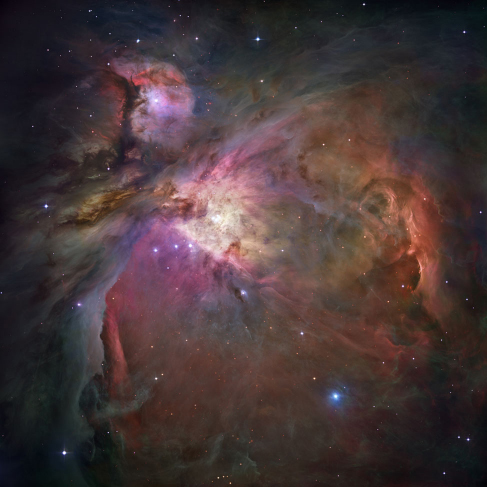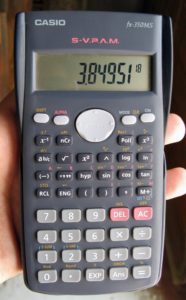Chapter 1 Science and the Universe: A Brief Tour
1.4 Numbers in Astronomy and Scientific Notation or Powers of Ten
In astronomy we deal with distances on a scale you may never have thought about before, with numbers larger than any you may have encountered. We adopt two approaches that make dealing with astronomical numbers a little bit easier. First, we use a system for writing large and small numbers called scientific notation (or sometimes powers-of-ten notation). This system is very appealing because it eliminates the many zeros that can seem overwhelming to the reader. In scientific notation, if you want to write a number such as 500,000,000, you express it as 5 × 108. The small raised number after the 10, called an exponent, keeps track of the number of places we had to move the decimal point to the left to convert 500,000,000 to 5. If you are encountering this system for the first time or would like a refresher, we suggest you look at Appendix Scientific Notation for more information. The second way we try to keep numbers simple is to use a consistent set of units—the metric International System ofUnits, or SI (from theFrench Système International d’Unités). The metric system is summarized in Appendix Metric System
A common unit astronomers use to describe distances in the universe is a light-year, which is the distance light travels during one year. Because light always travels at the same speed, and because its speed turns out to be the fastest possible speed in the universe, it makes a good standard for keeping track of distances. You might be confused because a “light-year” seems to imply that we are measuring time, but this mix-up of time and distance is common in everyday life as well. For example, when your friend asks where the movie theater is located, you might say “about 20 minutes from downtown.”
So, how many kilometers are there in a light-year? Light travels at the amazing pace of 3 × 105 kilometers per second (km/s), which makes a light-year 9.46 × 1012 kilometers. You might think that such a large unit would reach the nearest star easily, but the stars are far more remote than our imaginations might lead us to believe. Even the nearest star is 4.3 light-years away—more than 40 trillion kilometers. Other stars visible to the unaided eye are hundreds to thousands of light-years away as seen in Figure 1.

Scientific Notation
In 2015, the richest human being on our planet had a net worth of ?79.2 billion. Some might say this is an astronomical sum of money. Express this amount in scientific notation.
Solution
79.2 billion can be written 79,200,000,000. Expressed in scientific notation it becomes 7.92 × 1010.
Getting Familiar with a Light-Year
How many kilometers are there in a light-year?
Solution
Light travels 3 × 105 km in 1 s. So, let’s calculate how far it goes in a year:
- There are 60 (6 × 101) s in 1 min, and 6 × 101 min in 1 h.
- Multiply these together and you find that there are 3.6 × 103 s/h.
- Thus, light covers 3 × 105 km/s × 3.6 × 103 s/h = 1.08 × 109 km/h.
- There are 24 or 2.4 × 101 h in a day, and 365.24 (3.65 × 102) days in 1 y.
- The product of these two numbers is 8.77 × 103 h/y.
- Multiplying this by 1.08 × 109 km/h gives 9.46 × 1012 km/light-year.
That’s almost 10,000,000,000,000 km that light covers in a year. To help you imagine how long this distance is, we’ll mention that a string 1 light-year long could fit around the circumference of Earth 236 million times.
Learning Objectives
(Originally from OpenStax College Chemistry 1st Canadian Edition https://opentextbc.ca/introductorychemistry/ )
Quantities have two parts: the number and the unit. The number tells “how many.” It is important to be able to express numbers properly so that the quantities can be communicated properly.
Standard notation is the straightforward expression of a number. Numbers such as 17, 101.5, and 0.00446 are expressed in standard notation. For relatively small numbers, standard notation is fine. However, for very large numbers, such as 306,000,000, or for very small numbers, such as 0.000000419, standard notation can be cumbersome because of the number of zeros needed to place nonzero numbers in the proper position.
Scientific notation is an expression of a number using powers of 10. Powers of 10 are used to express numbers that have many zeros:
100 = 1
101 = 10
102 = 100 = 10 × 10
103 = 1,000 = 10 × 10 × 10
104 = 10,000 = 10 × 10 × 10 × 10
and so forth. The raised number to the right of the 10 indicating the number of factors of 10 in the original number is the exponent. (Scientific notation is sometimes called exponential notation.) The exponent’s value is equal to the number of zeros in the number expressed in standard notation.
Small numbers can also be expressed in scientific notation but with negative exponents:
10−1 = 0.1 = 1/10
10−2 = 0.01 = 1/100
10−3 = 0.001 = 1/1,000
10−4 = 0.0001 = 1/10,000
and so forth. Again, the value of the exponent is equal to the number of zeros in the denominator of the associated fraction. A negative exponent implies a decimal number less than one.
Examples
A number is expressed in scientific notation by writing the first nonzero digit, then a decimal point, and then the rest of the digits. The part of a number in scientific notation that is multiplied by a power of 10 is called the coefficient. Then determine the power of 10 needed to make that number into the original number and multiply the written number by the proper power of 10. For example, to write 79,345 in scientific notation,
79,345 = 7.9345 × 10,000 = 7.9345 × 104
Thus, the number in scientific notation is 7.9345 × 104.
For small numbers, the same process is used, but the exponent for the power of 10 is negative:
0.000411 = 4.11 × 1/10,000 = 4.11 × 10−4
Typically, the extra zero digits at the end or the beginning of a number are not included.
Example 1 Express these numbers in scientific notation.
306,000
0.00884
2,760,000
0.000000559
Solution
The number 306,000 is 3.06 times 100,000, or 3.06 times 105.
In scientific notation, the number is 3.06 × 105.
The number 0.00884 is 8.84 times 1/1,000, which is 8.84 times 10−3.
In scientific notation, the number is 8.84 × 10−3.
The number 2,760,000 is 2.76 times 1,000,000, which is the same as 2.76 times 106. In scientific notation, the number is written as 2.76 × 106. Note that we omit the zeros at the end of the original number.
The number 0.000000559 is 5.59 times 1/10,000,000, which is 5.59 times 10−7. In scientific notation, the number is written as 5.59 × 10−7 .
Test Yourself
Express these numbers in scientific notation.
23,070
0.0009706
Answers
2.307 × 104
9.706 × 10−4
Another way to determine the power of 10 in scientific notation is to count the number of places you need to move the decimal point to get a numerical value between 1 and 10. The number of places equals the power of 10. This number is positive if you move the decimal point to the right and negative if you move the decimal point to the left.
Many quantities in science are expressed in scientific notation. When performing calculations, you may have to enter a number in scientific notation into a calculator. Be sure you know how to correctly enter a number in scientific notation into your calculator. Different models of calculators require different actions for properly entering scientific notation. If in doubt, consult your instructor immediately.
Key Takeaways
Standard notation expresses a number normally.
Scientific notation expresses a number as a coefficient times a power of 10.
The power of 10 is positive for numbers greater than 1 and negative for numbers between 0 and 1.


